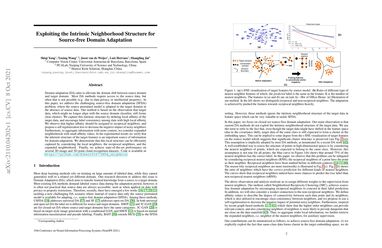Exploiting the Intrinsic Neighborhood Structure for Source-free Domain Adaptation
Domain adaptation (DA) aims to alleviate the domain shift between source domain and target domain. Most DA methods require access to the source data, but often that is not possible (e.g. due to data privacy or intellectual property). In this paper, we address the challenging source-free domain adaptation (SFDA) problem, where the source pretrained model is adapted to the target domain in the absence of source data. Our method is based on the observation that target data, which might no longer align with the source domain classifier, still forms clear clusters. We capture this intrinsic structure by defining local affinity of the target data, and encourage label consistency among data with high local affinity. We observe that higher affinity should be assigned to reciprocal neighbors, and propose a self regularization loss to decrease the negative impact of noisy neighbors. Furthermore, to aggregate information with more context, we consider expanded neighborhoods with small affinity values. In the experimental results we verify that the inherent structure of the target features is an important source of information for domain adaptation. We demonstrate that this local structure can be efficiently captured by considering the local neighbors, the reciprocal neighbors, and the expanded neighborhood. Finally, we achieve state-of-the-art performance on several 2D image and 3D point cloud recognition datasets. Code is available in https://github.com/Albert0147/SFDA_neighbors.
PDF Abstract NeurIPS 2021 PDF NeurIPS 2021 Abstract




 Office-Home
Office-Home
 Office-31
Office-31
 VisDA-2017
VisDA-2017
